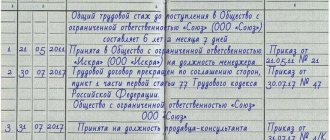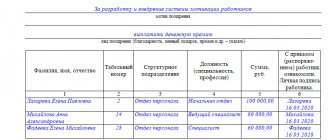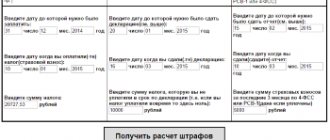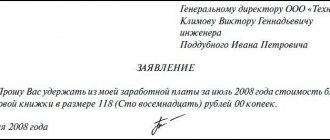Home / Labor Law / Labor Code / Work experience
Back
Published: 05/09/2017
Reading time: 7 min
0
2188
According to labor legislation, every working citizen has the right to receive twenty-eight days of rest time from his employer annually. And for some categories of employees, an additional vacation period is added to the standard vacation (Article 116 of the Labor Code).
To receive such leave, the employee must accumulate a certain length of service, which, according to the Labor Code, will allow the employer to send the employee on vacation . This period is paid for the employee. And you can count on it only after working at a specific enterprise for a certain period established by labor legislation.
- When is the vacation issued?
- What does the vacation period depend on?
- Experience accounting
- How is the calculation made?
- Accounting in enterprise documents
Dear readers! To solve your problem, call hotline 8 or ask a question on the website. It's free.
Ask a Question
When is the vacation issued?
According to the provisions of the mentioned article of labor legislation, the basis for issuing an annual paid vacation period is the employee’s desire to receive such rest, expressed in his application.
Having received such a statement, the employer does not have the right to refuse to satisfy the employee’s request.
After all, the initiator of registration according to the law is the employee himself and his desire to receive such leave. When drawing up a vacation schedule at an enterprise or organization, the wishes of all employees, that is, their statements (if any have been written), must be taken into account.
Experience for obtaining the right to provide management with a vacation period
represents a certain period that an employee is required to work at a specific enterprise. In this case, exclusively continuous work activity is taken into account.
The main periods included in such length of service are provided for by labor legislation. However, an enterprise or organization may have local regulations in force, according to which other additional periods include continuous service. If they are provided for in the collective labor agreement, they must also be included in the calculations when applying for leave.
Periods not included in the vacation period
The time of absence of an employee, which is subject to exclusion from the vacation period, is reflected in Art. 121 Labor Code of the Russian Federation:
- passes without supporting documentation. Absences are entered in the form of a code in the report card according to form No. T-12;
ATTENTION! The absence of an employee must be recorded with a memo and an order for disciplinary action.
Codes for indicating absenteeism in the report card
The manager evaluates the validity of the reason. He can include this day in the length of service if the employee, for example, found himself in an emergency situation or did not work due to non-payment of wages for more than 2 weeks. In this case, the code “NN” (30) is entered into the timesheet.
- leave to care for a child up to 3 years old. It is entered in the report card with the designation “OZH” (15);
- administrative leave of more than 14 days per year;
- other absences due to the fault of the employee (due to being under the influence of alcohol or drugs, missing a medical examination, an occupational safety exam, and so on).
What does the vacation period depend on?
According to the general rules reflected in Article 122 of the Labor Code, the right to an annual fully paid rest period arises after six months of continuous work at a specific enterprise.
But this rule has its exceptions. Certain categories of employees can receive leave regardless of the length of leave, that is, in advance. These include:
- employees under the age of eighteen (122nd and 267th articles of the Labor Code);
- employees who are adoptive parents of a child or several children under the age of three;
- employees who will soon go on leave for pregnancy and upcoming childbirth or who have recently returned from such leave (Article 122 of the Labor Code, part three).
Also, Article 122 of the Labor Code provides for extraordinary receipt of rest, regardless of the schedule approved by the enterprise. For example, this preferential category includes veterans, liquidators of man-made disasters, external part-time workers and other employees.
Husbands of women who are already on leave due to pregnancy and upcoming childbirth have the right to count on extraordinary vacation days (according to Article 123 of the Labor Code, part four).
Periods worked that are counted towards vacation time
These are all the days when the employee fulfilled his duties under the employment contract, including on a business trip.
As for part-time workers and part-time workers, despite the fact that their working hours are shorter, their vacation period does not decrease, that is, it is considered exactly the same as for all other employees.
Based on the timesheet, the days indicated by the following codes must be counted as time worked as vacation time.
| Employee personal card | |
| Order | The organization’s timesheet records the work schedule of each employee, while unaccounted periods are marked with special codes in the form of letters or numbers:
Time sheet |
Experience accounting
Every employer is required to keep records of all periods for which an employee is granted annual leave. Information of this kind is recorded in several documents at once, filled out according to a certain unified form:
- in the employee’s personal account (T-54);
- his personal card (T-2);
- in the issued order, which is one of the grounds for granting a vacation period (T-6).
The legislation provides for separate periods included in the duration of the vacation period. According to Article 121 of the Labor Code, these include:
- directly the annual period of paid vacation days;
- unpaid vacation periods not exceeding a total duration of two weeks per year;
- leaves granted in connection with pregnancy and upcoming childbirth;
- leaves granted in connection with the adoption of children;
- periods of study paid to the employee.
Also, Article 121 of the Labor Code provides for periods that, in calculations, are not included in the total length of service required to obtain the right to annual leave. These include:
- vacation periods lasting more than fourteen days a year, taken at one’s own expense;
- periods of leave issued in connection with the need to care for children.
Experience accounting
The employing company must include in reporting all time intervals during which the employee is entitled to rest.
Table. Documents that record time for assigning leave
| Document's name | Fill out form |
| Personal account of an employee |
As for the time of absence from work for a full working day for a good reason (and this is assessed by the employer himself), such a period can be included in the length of leave. For example, if an employee did not go to work because he had an accident on the way to work. An employee’s absence from work due to suspension of work due to a delay in payment of wages by more than
Rostrud explained to us how to correctly reflect on a timesheet the day of absence from work for a valid reason.
FROM AUTHENTIC SOURCES
“ An employee’s absence from work for a valid reason not related to temporary disability does not mean that he should be given unpaid leave for these days. After finding out the reason for absence from work, the letter code “NN” or a numeric code remains on the report card
2. Time of parental leave until the child reaches the age of 3 years. In a standard situation, when an employee uses this leave in full, this is the time from the day following the last day of maternity leave for the mother until the day when the child turns 15. In the report card, this leave is indicated by the letter code “OZH” or the numeric “15”.
3. Vacation time at your own expense in excess of 14 calendar days per working year, indicated by the letter codes “DO” or “OZ” or the numeric codes “16” or “17”.
How is the calculation made?
- The calculation period includes working years. The period for calculating the first such year begins from the moment of concluding an employment contract at a specific enterprise or organization. The next year is calculated from the day following the end of the previous year.
- It must be taken into account that the calendar and working year are completely different concepts. A year of work includes twelve months of continuous work activity. Accordingly, for each employee an individual calculation of work and vacation experience is carried out.
- Employees should also understand that they have the right to apply for leave if an employment contract has been concluded and all documents related to work activity have been formalized.
- At the same time, the calculation period required to provide annual rest is not affected in any way by the presence of part-time working days. The main thing is that the employee was present at the workplace that day and performed his official duties.
- Since special calculation programs do not take into account the periods included in the vacation period, the employee can independently enter data into an Excel spreadsheet to determine his length of service for the annual vacation period.
Dismissal due to moving to another city is an important reason for canceling “work off”. How can you punish workers without breaking the law? Read about this in our article. Read about what the seller should do if a shortage is discovered here.
How to calculate vacation time - step-by-step instructions
In general, there are 4 steps that will help you correctly calculate the length of service that gives you the right to basic annual paid leave.
Step by step calculation procedure:
- The start of work is determined - the day of hiring;
- Periods are identified that are not included in the length of service (they do not give the right to basic annual paid leave), which periods need to be excluded are written below;
- The total work time is divided into working years, taking into account unaccounted periods;
- For each working year, a vacation of the duration established for the employee is due.
When calculating vacation experience, the employee’s work schedule and mode, full or part-time work week (day) does not matter.
The length of the working day (working week) does not matter when calculating the length of service giving the right to labor leave.
This is due to the fact that the provisions of the Labor Code of the Russian Federation regarding the provision of paid leave are the same for all persons with whom employment agreements have been signed. Part-time employees have the same rights as full-time employees.
In order to correctly calculate the length of service that entitles you to basic annual leave with the payment of vacation pay, you need to know which periods of workers’ working activity do not need to be included in the length of service.
Periods not included in the vacation period
The periods not included in the length of service are established by Article 121 of the Labor Code of the Russian Federation. According to this article, you do not need to include:
- Periods of being on leave without pay (provided at your own expense) in an amount exceeding 14 calendar days per working year;
- Days when the employee did not go to work without good reason (absenteeism);
- Periods of parental leave up to 1.5 and up to 3 years;
- An employee is not allowed to work due to the fault of the worker himself, for example, due to violation of labor regulations, discipline, or being under the influence of drugs or alcohol (suspension under Article 76 of the Labor Code of the Russian Federation).
All these days increase the working year. For clarity, you can see an example of calculating the length of service that gives the right to paid leave, presented below.
What periods are included in the length of service?
All other calendar days that do not fall into the categories indicated above are included in the insurance period, that is, these are:
- days of work duties;
- periods of business trips (business trips);
- sick leave due to one’s own disability or in connection with caring for loved ones;
- being on leave without pay within 14 days per year;
- all other vacation periods, except for child care (main, educational, maternity, additional);
- temporary downtime in work with preservation of salary and job due to the fault of the employer;
- holidays recognized as days off;
- calendar days off;
- forced absenteeism due to illegal dismissal with subsequent reinstatement of labor rights;
- the time when an employee is suspended from work duties due to the lack of a certificate of examination from the medical board, unless this is considered to be the worker’s fault.
Is maternity leave included in the length of service?
The period of maternity leave is not specified in Article 121 of the Labor Code as a non-included period, and therefore maternity leave is included in the length of service.
Therefore, a woman on maternity leave does not have her work experience interrupted. This is the difference between maternity leave and parental leave for up to 1.5 years. If a woman takes parental leave after maternity leave, then this period is not included in the length of service giving the right to annual basic paid leave.
For each month of maternity leave, a woman will receive 2.33 vacation days (if the total annual duration is 28 calendar days); for each month of maternity leave, the employee will not receive labor leave.
Is administrative leave included in the length of service?
Leave without pay is partially included in the length of service. For the first 14 days of vacation without pay, annual leave is granted; for subsequent days it is not granted.
Example of calculating vacation time
Employee Korovkina was hired by the organization on 10/01/2014. Starting from the start of her working life, at the time of calculations (February 13, 2020), Korovkina had the following deviations from the normal working day:
| Periods of work | Length of period | Included/excluded from seniority |
| Sick leave | from 03/10/2015 to 03/18/2015 from 02/05/2016 to 02/10/2016 | Turns on |
| Labor paid basic annual rest | from 01.11.2015 to 28.11.2015 from 01.09.2016 to 28.09.2016 | Turns on |
| Vacation without pay (at your own expense) | from 06/10/2015 to 06/30/2015 | Excludes 7 cal days (21-14) |
| Suspension from work due to failure to pass a labor safety knowledge test | from 01.11.2016 to 03.11.2016 | Excluded |
| Being on a business trip | from 12/10/2016 to 12/17/2016 | Turns on |
According to the Labor Code of the Russian Federation, an employee has the right to 28 calendar days of basic paid labor leave for each working year:
| Working year | Period | Duration of basic annual paid rest | Explanations |
| First | From 01.10.2014 to 07.10.2015 | 28 cal days | Sick leave in March 2020 is included in the length of service. 7 days without pay in June 2020 are excluded, so Korovkina’s working year will end 7 days later. |
| Second | From 08.10.2015 to 07.10.2016 | 28 cal days | Sick leave in February 2020 is included in the length of service. The main rest in November 2020 and September 2020 is included in the length of service. There are no excluded periods in this working year. |
| Third | From 08.10.2016 to 10.10.2017 | At the time of calculations on February 13, 2020, for the third working year, Korovkina can receive an annual paid vacation for 4 months (28/12) * 4 = 9.32 cal days. | Business travel in December 2020 is included. Three days of suspension in November 2020 are not included. The working year is increased by three excluded days. |
Why do you need to count vacation time?
This calculation must be carried out to determine the moment when the employee’s next working year ends and he can qualify for a full 28 calendar days of paid rest.
You also need to make calculations when dismissing an employee, when compensation for unused days is calculated. In this case, the length of service that gives the right to work leave is considered, the total number of vacation days for the entire period of work is determined, taking into account working years, and then the number of days already used is subtracted. The resulting result is the number of days for which the employer must accrue vacation pay.
Calculation of length of service for additional paid leave
Those working in dangerous and harmful working conditions have the right to additional paid vacation days for “harmfulness”. In this case, the calculation of the length of service giving the right to such days is carried out in a special way, different from that described above.
A set number of additional days are also provided for each working year. The length of service for the provision of additional days includes only those periods during which the employee actually worked in harmful and dangerous conditions.
The calculation of the duration of additional leave is determined at the moment preceding the start of it.
The peculiarities of calculating length of service in this case are that days of primary and additional leave, sick leave, and maternity leave are not taken into account. Only days worked are taken into account.
To correctly determine the length of service, you need to follow the step-by-step procedure presented below.
Step-by-step instructions for calculating vacation time for additional days provided “for harmfulness”:
- The days that the employee worked in dangerous or harmful conditions are counted (and only full working days are taken into account if for the position in the “Name of productions...” section of the List of hazardous productions “permanently working” is written down; if there is no such entry, then the days when the employee worked at least half of the full working day);
- Based on the resulting number of days, the number of full months of activity in unfavorable conditions is calculated, the result is rounded to full months;
- The number of additional vacation days is counted.
The number of full months worked is calculated separately for each calendar year. If the working year covers 2 calendar years, then the calculation is carried out separately for each. The result adds up.
Formula for calculating the number of full months of work in unfavorable conditions:
Number of PM = days worked in a calendar year / number of working days in a year on average per month.
The second parameter is calculated as the number of working days indicated in the production calendar, divided by 12 months.
For every full 12 months, a set number of additional vacation days is due. The employee will receive the same number of days for a full 11 months.
If the employee worked less than 11 full months, then the number of additional vacation days is calculated using the following formula:
Number of additional days of departure = (Number of additional days per year / 12 months) * Number of full months of work – number of previously used additional days.
The result is rounded to full days.
An example of calculating length of service for additional leave “for harmfulness”
Bychkov has been working in hazardous conditions since 02/01/2016. During his work, he took one basic paid vacation of 28 calendar days. (from 12/01/2016 to 12/28/2016). The duration of annual additional leave is 7 calendar days. From 02/13/2017 Bychkov wants to go on additional leave, how many days can he count on if the following events occurred during his work:
- Sick leave – 6 working days (2016);
- Basic paid annual – 20 working days (2016);
- Without maintenance (at your own expense) – 5 working days (2017).
The working year falls on 2 calendar years - 2020 and 2020, so the calculation must be carried out separately for each.
- We count the number of days worked.
In 2020, Bychkov had 206 working days, taking into account excluded periods (sick leave and basic paid leave).
In 2020 – 20 working days, taking into account the exclusion of vacation days without pay.
- We count the number of full months.
Number of PM in 2020 = 206 / (247 / 12 months) = 10 months.
Number of PM in 2020 = 20 / (247 / 12 months) = 1 month.
- Counts the number of additional vacation days due as of February 13, 2020.
For a full 11 months, an employee has the right to receive 7 additional days of rest.
Periods that do not count towards vacation time
1. The time the employee is absent from work without good reason.
In the timesheet (form, these days are indicated by the following codes.
CodePeriods of workPR (24)AbsenteeismNB (35)Suspension from work without pay| Code | Operating periods |
| Me (01) | Daytime work |
| N (02) | Night work |
| RV (03) | Work on weekends and holidays |
| C (04) | Overtime work |
| VM (05) | Shift work |
| K (06) | Business trip |
| UV (12) | Work on reduced working hours for persons combining work with on-the-job training |
| Champions League (21) | Work of persons under conditions of reduced working hours in accordance with the law (for example, minors, disabled people, persons employed in work with hazardous working conditions) |
| NS (25) | Part-time work |
Periods included in the vacation period
Periods worked by a citizen and unworked may be counted towards length of service (Article 121 of the Labor Code of the Russian Federation):
- work activities, including business trips;
- vacation;
- weekends and official holidays;
- absences due to illness;
- decree;
- studying at an accredited educational institution;
- passing a medical examination;
- maternity leave for adoptive parents of a newborn baby;
- easy to work with;
- days off provided for blood donors caring for a disabled child;
- leave without pay up to 14 days;
- downtime in case of wrongful dismissal and subsequent return to work;
- suspension of the enterprise's activities after inspection by authorized bodies, strike.
With part-time or part-time employment, it is not taken into account that working time is shorter than with a standard schedule, that is, the length of service for this category of persons does not decrease (Article 93 of the Labor Code of the Russian Federation).
Accounting codes in the time sheet included in the vacation record
Accounting codes in the time sheet for unworked days included in the vacation period
When adding time to the length of service when a person was not engaged in work activities, it does not matter whether payment was transferred to him.
The vacation period also includes days when an employee is suspended from work on the basis of:
- failure to undergo a medical examination, while the employee was not found guilty;
- suspension from work for up to 4 months based on a medical report if transfer to another position is impossible;
- failure to complete training, testing on labor protection, professional skills due to third-party reasons.
Regulatory regulation
Regulatory acts governing the application of the concept of “length of service” when calculating various types of vacations and pension benefits:
- Law of December 28, 2013 No. 400-FZ “On Insurance Pensions” has been applied since January 1, 2015. It contains the concept and procedure for assigning labor pensions, explains the concept of length of service, covering the time periods that are included in it,
- The Labor Code of the Russian Federation (in particular, Article 314) is the main Law applied in the sphere of regulation of labor relations.
Watch the video. About work experience, points and pre-retirement:
https://youtu.be/tgt1EQhF91U











